Janapada Sampada
Miscellaneous Art and Crafts of Arunachal Pradesh
Introduction
Arunachal Pradesh is the home to a large number of tribes and sub-tribes. It has a rich tradition of craftsmenship, which manifests itself in various arts and crafts produced by these tribes. The Buddhist including Monpas, Sherdukpen, Aka, Bugun et al make beautiful masks, carpets and painted wooden vessels. The Bangis and Apatani make bag, hat, jewellery etc. Khamtis and Wanchos are well known for their wood carving. Pottery of Dafla women is well-known.
Ornaments
Ornaments making is a craft widely practised in Arunachal Pradesh. The work of a silver smith is more intricate and artistic. The first stage in the manufacture of the traditional ornaments he makes, is to make a wax mould of the ornament. This is done by warming the wax sticks or coils and then placing them on the standard moulds made of wax and wood. Where design are essential, they are made with thin wax coils and cut with a knife where necessary.
Once the wax mould is ready, the next stage is to make the earthen container for mould and metal. For this purpose, a wet mixture of clay and charcoal dust called takam is used. A lump is placed on a bamboo frame and shaped flat with a knife and spittle. The mould is first covered inside with charcoal dust and then placed on it. A small plug of wax is stuck to it, joining it at the other end to the bottom opening of a small banana-leaf funnel. The mould and the funnel are finally covered with charcoal dust, shaped to smoothness, and allowed to dry near a fire. After sometime the banana funnel is removed and the empty place is filled with metal pieces. The mouth is covered with a potsherd, and sealed with charcoal dust. It is dried again. A hole is made almost in the centre of the funnel and the earthen container is ready for the next operation which is burning. The hard and dry wood of the taja tree is used for melting metal. The earthen container, with its mouth downwards is supported on the hearth-stones. It is covered with fire wood and set to fire. After about twenty minutes the metal is tested by inserting an iron rod in the hole. When it turns into liquid and discharges a turquoise flame, the earthen container is removed with the help of two pairs of strong bamboo tongs and slowly turned upside down. The wax in the mould is burnt by then and the plug has disappeared, leaving a passage for the molten metal to pass into the mould. The molten metal fills the empty space created by the wax mould. This is what is technically known as the cire perdue process, and is prevalent in Mexico and other parts of the world. The ornaments thus cast is taken out by breaking the earthen container. It is scraped with a knife and rubbed with stones to make it clean and bright.
Besides beads of various colours and sizes blue feathered wings of birds and green wings of beetle are used in decoration. The Noctes and Wanchos tribals weave the beads in their own unique and distinct patterns. Wanchos make ear-ornaments from glass beads, wild seeds, cane, bamboo and reed.
The gallong women wear ear-plugs and the earring. Plugs are generally of leaf, wood or bamboo, while the rings are heavy for they are made of iron. The rings are coiled in several turns and specially used by the Karka Gallong women. Very often women have their ear-lobes slashed due to the heavy weight of the ornaments. Yet, the women never give up wearing them. In such cases, the rings are not worn in the lobes but are suspended with the help of a string below the ear- lobes. Bead necklaces are worn by both men and women alike. Every bead has its own value, according to its colour and lustre. Sometimes, the bead necklaces are so numerous and heavy that if there is no cloth over the breasts, these bead necklaces can easily cover them. Brass wristlets are common and three to eight wrislets with increasing circumference from wrist to elbow are worn by the women. Around the waist, men wear several cane strips, which with constant use attain a shine and smoothness. Iron discs, varying in number and fastened together with a cane string or thread are worn by women around their waist. The larger disc is in the middle, hanging in front and the succeeding ones gradually diminish in size and are on both sides of the largest one towards the thighs. Women generally wear cane anklets. A thin strip of cane work is woven on the legs between the ankle and the knee. Necklaces made of metal coins are much favoured by the Gallong women. Such necklaces generally contain one -rupee, eight-anna and four anna coin. Hooks are made on the coins and these are suspended with thread. Waist band of leather, studded with stones is another ornament. The stone are bigger in front and smaller towards the end. One such band generally contains from 100 to 150 stones.
The Aka women wear number of ornaments of silver. The common silver ornaments are melu- a flat-shaped ornament worn over the chest, rombin- the big ear bulbs, gichli- the ear- rings and gejjui-the wristlets. Well-to-do women specially wear a fillet of silver chain work called lenchhi. Along with these ornaments, women also put on around the neck a number of coloured bead-necklaces. Ancestral necklace called aesheri, is worn invariably by women and often by men. It forms a necessary part of a girl’s dowry to be given to the groom at the time of marriage. It is regarded as sacred and more valuable than other ornaments since it is a part of the ancestral property of the house.
The ornaments of the idu mishmis are few and simple. The men and women wear necklaces of various kinds of beads. The most common necklace is the arulaya, which consists of forty to sixty white beads strung together. Another kind of necklace is the lekapon made of small white beads in twenty strands. Usually both men and women wear a cylindrical piece of bamboo in the extended lobe of the ear: some wear silver rings adorned with either silver coins or beads of red and blue. Akakhre are earring made of thin silver-plate and worn by women.
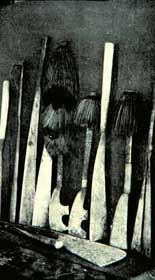
Various kinds of Dao
Weapons are an integral part of the tribal life since the times immemorial. Although certain weapons have become obsolete and replaced by modern weapons yet traditional weapons have a place of their own. Weapons are used in war and chase and day to day task. All such weapons are produced locally. The most important weapon of Akas is bow and arrow, known by the names of tkeri and moo respectively, and used extensively in the chase. Weapons may vary in size according to the user`s requirement. The bigger ones used in hunting are fitted with tips of iron and smeared with aconite poison. The bows are usually hung over the shoulders while the arrows are carried in a case of bamboo called Thouvou.
Another weapon, orignally of war but now of defence, is a kind of crude harpoon, one end of which is barbed with sharp iron nails. It is hurled at the target from a distance.
The most common weapon used both in war and peace is the dao. It is of extensive use to the people in their day-to-day task such as cutting wood and bamboo pieces, clearing shrubs and other growth in the forest etc. It is made of steel and is usually covered with bamboo sheath when not in use. The local term for dao is wetz.
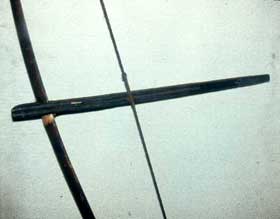
Bow & Arrow
Like Akas, Pailibos also use different kinds of weapon. They keep it in a special place. Some of the weapons used by them are as follows-
a) UYI-A bamboo bow with a cane string.
b) UPUK-A bamboo arrow without an iron tip or a poison.
c) MORA-A bamboo arrow with an iron tip.
d) GEB-BU-A quiver made from hollow bamboo with a bamboo lid.
e) NYIBU-A pointed spear with long wooden pole and iron blade. It has a shaft made of a long pole of dry and hard wood. Below the metal head there is tuft of yak or horse hair.
f) YOKSE-A big steel dao or sword.
g) SOTAM-A shield made of bamboo and cane.
h) CHOBUK-It is a sheath for the dao or medium size dagger made from cane and strengthened with pieces of wooden strips.
f) EG-GYI -An iron axe used for felling trees and for slaughtering mithuns during sacrifice.
War helmets with or without borders around domes, were made from strong variety of cane. Body cover or armour and leg covers or leg guards were also made from such cane and skin of bear or takin or mithun.
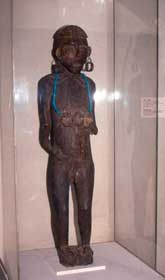
Head hunting
Wood carving is a tradition with some of the tribes of Arunachal Pradesh. The Monpas, Khamtis, Wanchos, Phom, Konyak tribes occupy significant place in this art. Wood carving like in the case of Nagaland finds expression mainly under three categories;firstly, with head hunting, secondly with the decoration of the morungs or men`s youth dormitory and thirdly, the funerary images erected for warriors and other important person. In carving of the human figure, special attention is paid to the head. The features are carved in low relief and are fairly realistic. Usually the image depicting a warrior is decorated with special cowerie belt and several other artefacts. The top of the head is rounded and usually has some indication of hair-cut. Tattoo marks are carefully represented, and most figures are dressed up with little bits of cloth and even ornaments with tufts on head or beads in the ear.
Wancho woodcarvers have deep sense of proportion, despite their pre-occupation with the head. Of late departure from the traditional fixed form is noticed in many carved figures. Symmetrical postures are replaced by assymetrical ones, relief works are experimented in various themes.
The Monpa wood carver make beautiful cups, dishes, fruit bowls and carve magnificant masks for ceremonial dance and pantomimes. The Sherdukpen The Khampa and the Monpa make masks which appear almost like real faces, while other represent birds and animals and some represent apes and men twisted mouths, women with goire to drive away the evil spirit. The masks are made of a single block of wood hollowed inside; holes are usually but not always, made for eyes and mouths; most masks are painted, but the older ones are generally found dark and discoloured. Women never wear the mask which are used only by men and boys.
The Khamptis makes beautiful religious images.
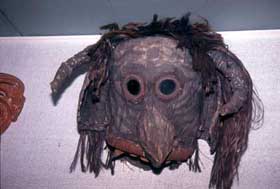
Mask, Demon Khompti tribe
Religious belief of some tribal communities especially in Arunachal Pradesh have been influenced in some respect by Hinduism and Buddhism. The Sherdukpens and the Monpas perform many kind of ritual masked dances of which Thutotdam is most fascinating. The dancers put on masks representing skulls and wear costumes designed as skeletons. The ritualistic dance depicts how the soul after death is received in the other world. At Torgyap Festival many such kinds of masked dances are performed which aim at driving away evil spirits and ensuring prosperity, good harvest and favourable weather throughout the year.
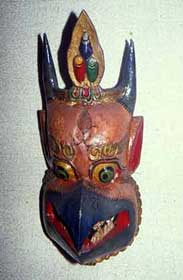
Mask, Bird Monpa tribe
The Monpas perform Arpos dance in which about twenty-five dancers, wearing helmets and carrying sword and shields like ancient warrior, depicts how the ancestors of the tribe conquered their enemies. The performance concludes with a dance number called Gallong Chham in which about ten dancers perform wearing very colourful costumes and sumptuous headgear.
Of all the masked pantomimes that the Sherdukpens perform, the most fasicinating is the Yak dance. The dummy animal is formed by two men concealed behind a black cloth that forms its body. The head of the dummy Yak is made of wood . On its back sits the figure of a goddess. Three masked men dance around the dummy animal. They represent the legendary hero Apapek and two sons. Verrier Elwin in The Art of the North-East frontier of India reports,”The lamas of the Yang Sang Chu valley in northern Siang have masked dances which they perform every year at the week-long festival of Drubachuk to ensure prosperity, happiness and health.
They too have Deer, Bird and Pig dances, for which there are striking masks and gorgeous costumes. Other pantomimes represent kings and queens, demons and clowns. The highly entertaining Arakacho-Chham originated, it is said when Lord Buddha saw how gloomy people were: he sent the clown Arakacho and his wife to cheer them up and they began to laugh. Similar dances are performed by the Membas of Gelling and elsewhere.
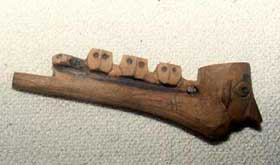
Smoking pipe
Palibos are fond of smoking therefore make smoking pipes from wood and bamboo roots, but they also procure metallic pipes through barter trade from their neighbours the Bokars, the Ramos and the Membas.
Elak-Tidu-Smoking pipe made of wood
Ete-tidu-Smoking pipe made of bamboo-root.
Ra-Tidu-Metallic pipe engraved and with a long neck.
Ata-Tidu-Smoking pipe made of silver.
Dance forms an important aspect of the socio-cultural heritage of the peole. They dance on important rituals, during festivals and also for recreation. The dances of the people of Arunachal are group- where both men and women take part. There are however some dances such as igo dance of the Mishmi priests, war dance of the Adis, Noctes and Wanchos, ritualistic dance of the Buddhist tribes, which are male dances. Females are not allowed to participate in these dances.
Some of the popular folk dances of the people are Aji Lamu(Monpa), Roppi(Nishing), Buiya(Nishing), Hurkani(Apatani), Popir(Adi), Pasi Kongki(Adi), Chalo(Nocte),Ponung(Adi), Rekham Pada (Nishing), Lion and Peacock dance (Monpa) and so on. Most dances are performed to the accompaniment of songs sung generally in chorus. Musical instruments like drums and Cymbals are played.
The folksong of Pailibos relate more to their folk history, mythology and description of their known past. Themes of songs are like fables involving creatures or the animal and urgent words signifying moral deduction.
Following are their chief folksong, sung on different occasion:
Ja-Jin-Ja: On occasion of feasts and merriment, during marriages or other social meets, this song is sung. Both men and women sing it in chorus or individually. But once the song starts, all those who are present join them in singing.
Baryi: It is a song which narrate their history, their religious lore and mythology. Its whole cycle takes hours to complete. It is also a feature of festivals or of occasion of important social or religious gatherings.
Both Ja-Jin-Ja and Baryi produce a nostalgic feeling in Pailibos as the glories of the past ancestors are narrated through them.
Nyioga: It is sung when a marriage ceremony is concluded and the bridal party returns leaving the bride in her home. The theme is that of the joy. It contains pieces of advice to the bride for her future life.
Dafla women are skilled in this craft. The legend is that Abo Takam was the first Dafla potter and from him the art passed on to the women. The process involves pounding a specific kind of earth called dekam on a big stone with a wooden hammer. When it turns into powder, water is mixed and it is hammered till it gains the required softness. Clay lumps are taken home. The woman sits with a piece of gunny bag, or old fibre blanket spread over her thigh. She takes a lump and shapes it with her finger into a crude pot with a shallow opening at the top and rim round it. When several such crude pots have been shaped they are kept in the top-most tray over the hearth to dry. Next day they are ready for the final processing. This is done by pushing a stone deeper and deeper through the hollow of the mouth to get the right bulge of the sides, which are beaten on the outer side with a kamgi to flatten them thin. The kamgi is a bamboo stick with a lineal design on it. It leaves the marks of the design on the body of the pot. The process is continued till the desired round shape, size and finish are obtained.
Finished pots are not subjected to any polishing or burnishing. They are carefully kept in the shade while drying. When completely dry, they are put in a fire out-side the house. There are no kilns or pot-ovens, though a ditch, if available, makes it convenient to put burning firewood over the pots. More or less forty minutes are sufficient to bake a pot. Pottery is exclusively limited to cooking utensils.




